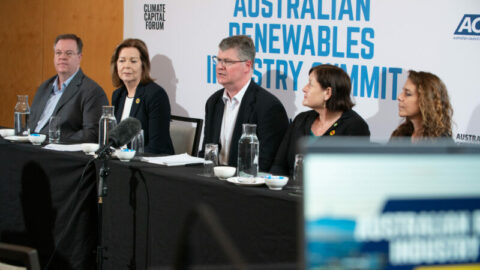by Carl Kitchen, Australian Energy Council
The unveiling of the Federal Government’s new legislation to clarify offshore energy developments was greeted with suggestions it would prompt a rush of offshore wind farms around our coastline.
On cue, the day after the Offshore Electricity Infrastructure Bill 2021 was introduced, Australis Energy went public with plans for a 600MW wind farm with up to 75 turbines about 10km off the South Australian coast near Kingston.
Project developers have lodged a development application with the SA State Planning Commission and it joins a list of more than a dozen possible projects highlighted in a recent report on the potential of offshore wind in Australia (shown in Table 1).

Table 1: Proposed offshore wind farm projects. Source: Offshore Wind Energy in Australia report by Blue Economy CRC.
Offshore wind farms typically take six to ten years to develop and build. Currently, many of these projects are in the pre-feasibility stage. The 2.2GW Star of the South project proposed off the Gippsland coast is the most advanced.
It is still in the feasibility phase, undertaking site investigations and monitoring of conditions. The project has the backing of local investors and the Copenhagen Infrastructure Partners (CIP) and expects that if the project is feasible and gains the necessary approvals, construction work could begin in the middle of this decade and the first electricity delivered at the end of the decade.
Federal Bill
The Federal Government’s Bill puts a regulatory framework in place for the construction, installation, commissioning, operation, maintenance and decommissioning of projects in the Commonwealth offshore area.
The Commonwealth offshore area is the waters three nautical miles (around 5.5km) offshore to the outer edge of Australia’s Exclusive Economic Zone (roughly 200 nautical miles).
According to the Offshore Wind Energy in Australia report, the “technically-accessible resource” is estimated to be 2233GW. Technically accessible refers to areas less than 100km offshore in water depths less than 1,000m and within 100km of substations and onshore transmission lines and excluding environmentally restricted areas.
That report also pointed to the lack of a federal regulatory framework for offshore renewables hindering development, so the recently released Bill helps address that. Under this framework, offshore infrastructure activities must be done in a way that does not adversely impinge on existing marine users.
This Bill ensures co-users are consulted ahead of any construction. Projects will only proceed if impacts can be appropriately managed.
Specifically, this Bill:
» Empowers the Minister to declare specified areas suitable for offshore infrastructure activities
» Empowers the Minister to grant licences for proponents to undertake offshore infrastructure activities in specified areas
» Provides for protection of offshore electricity infrastructure in the Commonwealth offshore area
» Establishes the statutory authorities to administer and regulate the framework
» Outlines compliance and enforcement of the regulatory framework
» Provides worker safety through the Work Health and Safety Act 2011
Why go offshore?
Offshore wind has tended to be developed in countries and regions where there is less opportunity onshore – either because of the wind resource, availability of land, or factors like population density. Key regions for offshore wind have been the UK and Europe (with The Netherlands leading the way), as well as South Korea and Japan.
Offshore wind farms are also more efficient with more wind resources, although this is countered by their increased cost to develop and maintain them. Offshore wind gross capacity factors greater than 80 per cent (excluding losses) are claimed for waters south of Tasmania, although these are in deeper waters, likely to be more challenging and are a long way from demand centres.
In more accessible areas, such as Bass Strait, Western Australia’s coast and north Queensland, “theoretical” offshore capacity factors of more than 55 per cent are widespread, according to Blue Economy Co-operative Research Centre. South Australia and New South Wales have capacity factors of more than 45 per cent.
The capacity factors for offshore wind farm sites in Australia are claimed to be 10-15 per cent higher than for onshore wind and by more than 25 per cent in some areas (see Figure 1).

Figure 1: Capacity factors for onshore and offshore wind 100m hub height. Source: Offshore Wind Energy in Australia report by Blue Economy CRC.
The capacity factors for offshore wind farm sites studied in the Offshore Wind Energy in Australia report (which were those close to substations at 25, 50 and 100km offshore and in waters less than 1,000m deep) are shown in Table 2.

Table 2: Gross capacity factors at selected sites. Source: Offshore Wind Energy in Australia report by Blue Economy CRC.
Offshore wind farms can also have larger turbines – it’s easier to install when they won’t impact neighbouring land use. Offshore turbines average 7.5MW compared to an onshore average of 3MW.
The biggest offshore turbine currently available is the massive 12-14MW Haliade-X which has a 220m rotor. It’s argued that offshore wind farms could help diversify supply to the grid by being available at times when solar and onshore wind are not.
The Blue Economy study looked at offshore wind resources hourly against grid load in Western Australia, South Australia, Victoria, Tasmania, New South Wales and Queensland and against other renewable generation onshore. Most sites showed strong diversification from onshore renewable generation.
But there is a big caveat to this assessment because the offshore and onshore wind resource data was not based on in-situ observations but taken from “coarse resolution global scale meteorological reanalysis”. The correlation of offshore wind with onshore wind sites estimated in the study is shown in Table 3.

Table 3: Correlation of offshore wind with onshore wind at selected sites. Source: Offshore Wind Energy in Australia report by Blue Economy CRC.
Show me the money
While more efficient, offshore wind farms are unsurprisingly more expensive to build and maintain. The International Renewable Energy Agency estimates the average levelised cost for onshore wind at US$39/ MWh (AUD$53/MWh) compared to US$84/ MWh (AUD$115/MWh) for offshore wind.
An assessment of technology costs for the Australian Energy Market Operator released in 2020 estimated the capital cost for an onshore wind farm using 4MW turbines at $1.7 million per MW compared to $5.4 million per MW for an offshore wind farming employing 9.5MW turbines, the CSIRO’s GenCost final report estimated the costs to be $1.9 million per MW for onshore wind and $5.6 million for offshore wind farms.
In shallower waters, wind turbines can be fixed to the seabed and internationally commercial wind farms are almost exclusively fixed foundations. The capacity of offshore wind farms with foundations in the seabed has nearly doubled in the past four years (19GW to 35GW), and amortised costs have dropped from $120/MWh to $80/MWh.
They are best suited to waters no deeper than 60m, while an estimated 80 per cent of offshore wind blows over deeper waters. For deeper waters, they can be put on floating platforms, which have been commercialised over the past decade. Four systems have emerged – semisubmersible, sparbuoy, tension leg platform, and barge.
In July, Shell and Scottish Power, which is part of Iberdrola, submitted proposals to build a large-scale floating wind farm off the Scottish coast.
One challenge highlighted by the Floating Wind Joint Industry Project (FWJIP) for floating wind farms with larger turbines is maintenance and servicing which can not only be technically challenging but can come with a price tag.
Approaches being looked at include climbing cranes, and vessels that can counter the effect of swell with motion compensation software, but the ships are estimated to cost $250 million.
In a recent FWJIP report, key findings included:
» Heavy lift maintenance: the relative motion of the turbine versus the maintenance vessel is a key risk and current heavy lift vessels, originally designed for the oil and gas industry, are not able to lift to the height of a 15MW turbine
» Tow-to-port: better solutions to safely disconnect and store all the connections when bringing the turbine back to port were researched, providing recommendations depending on the turbine platform design and the distance to port
» Mooring in challenging environments: both very deep and very shallow waters come with inherent challenges
for anchoring floating offshore wind platforms, from selecting the most cost-efficient mooring system, to mitigating the strong dynamic motions of waves experienced in shallow waters
So, work is underway on the best way to manage offshore floating wind farms and larger turbines.
Note: This article was originally published on the Australian Energy Council website.

















